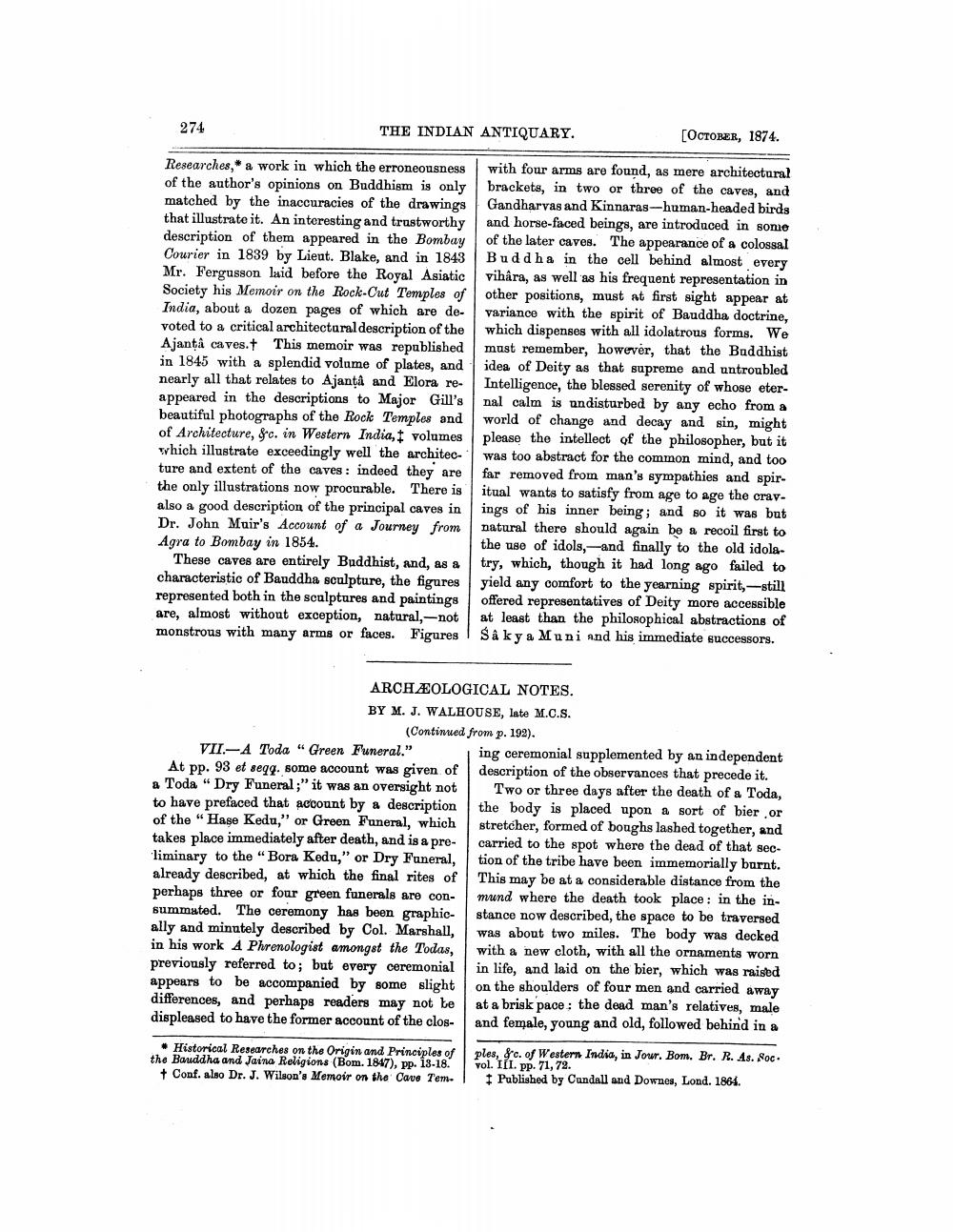________________
274
THE INDIAN ANTIQUARY.
Researches, a work in which the erroneousness of the author's opinions on Buddhism is only matched by the inaccuracies of the drawings that illustrate it. An interesting and trustworthy description of them appeared in the Bombay Courier in 1839 by Lieut. Blake, and in 1843 Mr. Fergusson laid before the Royal Asiatic Society his Memoir on the Rock-Cut Temples of India, about a dozen pages of which are devoted to a critical architectural description of the Ajanta caves. This memoir was republished in 1845 with a splendid volume of plates, and nearly all that relates to Ajantâ and Elora reappeared in the descriptions to Major Gill's beautiful photographs of the Rock Temples and of Architecture, &c. in Western India, volumes which illustrate exceedingly well the architecture and extent of the caves: indeed they are the only illustrations now procurable. There is also a good description of the principal caves in Dr. John Muir's Account of a Journey from Agra to Bombay in 1854.
These caves are entirely Buddhist, and, as a characteristic of Bauddha sculpture, the figures represented both in the sculptures and paintings are, almost without exception, natural,-not monstrous with many arms or faces. Figures
ARCHEOLOGICAL NOTES. BY M. J. WALHOUSE, late M.C.S. (Continued from p. 192).
VII-A Toda "Green Funeral." At pp. 93 et seqq. some account was given of a Toda "Dry Funeral;" it was an oversight not to have prefaced that account by a description of the "Hase Kedu," or Green Funeral, which takes place immediately after death, and is a preliminary to the "Bora Kedu," or Dry Funeral, already described, at which the final rites of perhaps three or four green funerals are consummated. The ceremony has been graphically and minutely described by Col. Marshall, in his work A Phrenologist amongst the Todas, previously referred to; but every ceremonial appears to be accompanied by some slight differences, and perhaps readers may not be displeased to have the former account of the clos
Historical Researches on the Origin and Principles of the Bauddha and Jaina Religions (Bom. 1847), pp. 13-18. + Conf. also Dr. J. Wilson's Memoir on the Cave Tem
[OCTOBER, 1874.
with four arms are found, as mere architectural brackets, in two or three of the caves, and Gandharvas and Kinnaras-human-headed birds and horse-faced beings, are introduced in some of the later caves. The appearance of a colossal Buddha in the cell behind almost every vihâra, as well as his frequent representation in other positions, must at first sight appear at variance with the spirit of Bauddha doctrine, which dispenses with all idolatrous forms. We must remember, however, that the Buddhist idea of Deity as that supreme and untroubled Intelligence, the blessed serenity of whose eternal calm is undisturbed by any echo from a world of change and decay and sin, might please the intellect of the philosopher, but it was too abstract for the common mind, and too far removed from man's sympathies and spiritual wants to satisfy from age to age the cravings of his inner being; and so it was but natural there should again be a recoil first to the use of idols, and finally to the old idolatry, which, though it had long ago failed to yield any comfort to the yearning spirit,-still offered representatives of Deity more accessible at least than the philosophical abstractions of Sakya Muni and his immediate successors.
ing ceremonial supplemented by an independent description of the observances that precede it.
Two or three days after the death of a Toda, the body is placed upon a sort of bier or stretcher, formed of boughs lashed together, and carried to the spot where the dead of that section of the tribe have been immemorially burnt. This may be at a considerable distance from the mund where the death took place in the instance now described, the space to be traversed was about two miles. The body was decked with a new cloth, with all the ornaments worn in life, and laid on the bier, which was raised on the shoulders of four men and carried away at a brisk pace: the dead man's relatives, male and female, young and old, followed behind in a
ples, &c. of Western India, in Jour. Bom. Br. R. As. Soc. vol. III. pp. 71, 72.
Published by Cundall and Downes, Lond. 1864.




